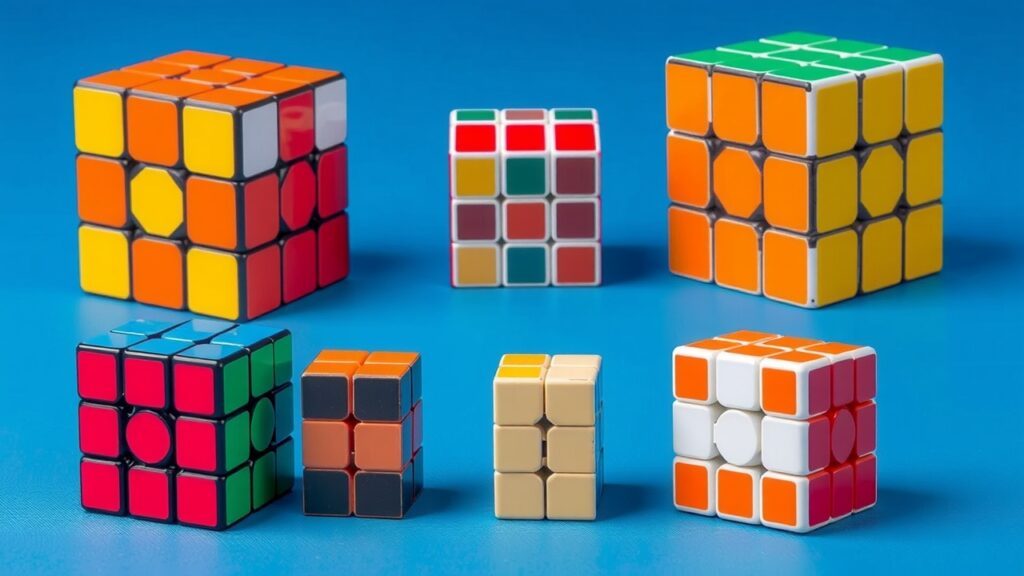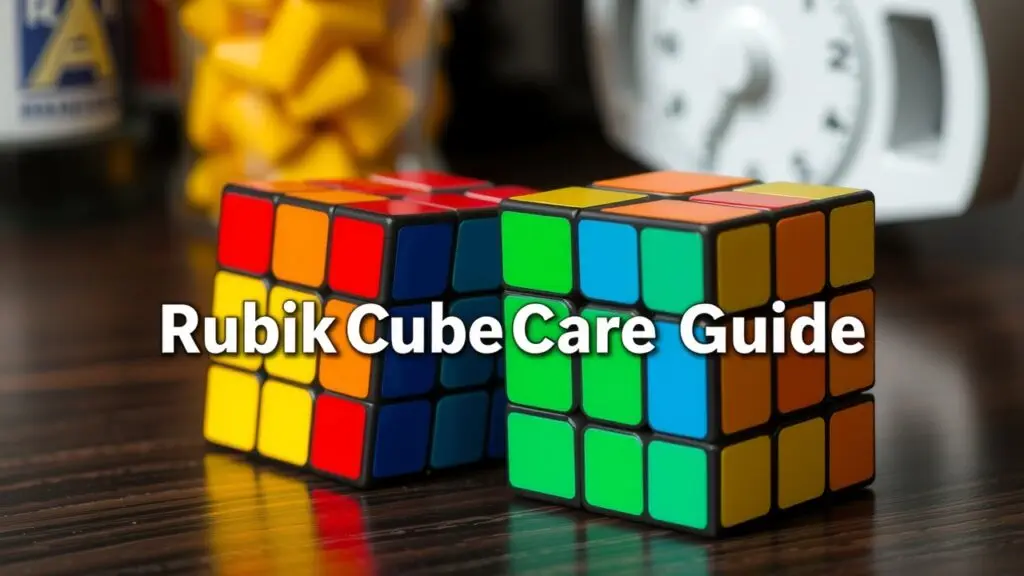Discover the types of Rubik’s Cubes, from the small 2×2 to massive challenges like the Megaminx. This guide covers various sizes and solving techniques.
What is a Rubik’s Cube?

A Rubik’s Cube, also known as a Magic Cube, is a 3D combination puzzle created by Erno Rubik in 1974. It has six faces, each covered in nine stickers of a single color when solved. The goal is to twist and turn the cube until every face shows only one color. This fun puzzle belongs to the twisty puzzles category and is famous around the globe for testing problem-solving skills.
Why Are There Different Types of Rubik’s Cubes?
There are many types of Rubik’s cubes because they come in various sizes, shapes, and levels of difficulty. This variety caters to different preferences and solving styles among fans:
- Standard cubes like the classic 3×3 are common.
- Smaller options, like the 2×2 cube, are great for beginners.
- Larger cubes, like the 4×4, or unique shapes like Megaminx or Square-1 add new solving challenges.
These variations allow everyone—from novices who want something easy to advanced speedcubers seeking quick solve times—to find puzzles that suit their interests.
Who Can Benefit From Learning About These Variations?
Different groups can gain from knowing about these variations.
- Beginner cubers can start with easier models before trying harder ones.
- Intermediate solvers look to sharpen their skills with new challenges.
- Speedcubing enthusiasts want faster solve times with special speed cubes.
- Puzzle collectors enjoy gathering unique designs or limited editions.
Exploring these options helps each group appreciate this engaging hobby while improving their skills at problem-solving.
Standard Sizes of Rubik’s Cubes (2×2 to Larger Order)
What are the different sizes of Rubik’s Cubes?
Rubik’s Cubes come in a variety of sizes. Each type offers its own set of challenges. The common types include the Pocket Cube (2×2), Classic Cube (3×3), and larger variants like the 4×4 and 5×5. Knowing these standard sizes helps enthusiasts pick a cube that matches their skill level.
Pocket Cube (2x2x2)
The Pocket Cube, or 2×2 Rubik’s Cube, is the smallest version. It has only eight corner pieces. This makes it perfect for beginners or for those who want a portable puzzle. Because it has less complexity, it’s easier to solve and great for learning basic concepts without feeling too pressured.
Classic Cube (3x3x3)
The Classic Cube is probably the most recognized type around the world. Created by Ernő Rubik in 1974, this cube has six faces with nine stickers on each side—fifty-four stickers total! It includes edge and corner pieces that allow for many moves and combinations. This cube is excellent for learning algorithms that are important for speedcubing.
Intermediate Challenges (4×4 – “Rubik’s Revenge”)
This cube is known as “Rubik’s Revenge.” The 4×4 cube adds more complexity with twelve edges and eight corners—making sixty-four smaller pieces to twist and turn! Solving this requires knowledge of parity errors that don’t happen in simpler cubes. It’s a good way to develop advanced strategies beyond just the basics.
Advanced Levels (5×5+ – Professor’s Cube & Beyond)
For those who are ready for even bigger challenges, there are larger cubes like the Professor’s Cube (5×5). These cubes come with a lot more permutations—over twelve quintillion ways to arrange them! Some designs use V-Cube technology which makes turning smoother but requires complex sequences to solve them.
Non-Cubic Shapes & Unique Variations
Popular Non-Cubic Twist Puzzles
Twisty puzzles go beyond the classic Rubik’s Cube. They bring a variety of shapes and mechanisms that challenge enthusiasts in new ways. Non-cubic shapes include designs like the Megaminx, Pyraminx, Skewb, Square-1, and Mirror Cube. Each variation offers unique solving techniques and appeals to different skill levels.
Megaminx – The Dodecahedron Puzzle
The Megaminx is a dodecahedron-shaped puzzle with twelve faces, each sporting its own color scheme. It operates similarly to the traditional 3×3 Rubik’s Cube but adds complexity due to its shape and number of sides. To solve it, you need to understand advanced techniques such as layer-by-layer methods or intuitive strategies used for standard cubes.
Key features of the Megaminx include:
- Twelve Faces: Each face has five pieces (corners) instead of three.
- Color Scheme: Usually bright colors that enhance visual appeal.
- Advanced Techniques: Many solvers use algorithms from other cube types while adapting them for this unique structure.
Despite these differences, many strategies overlap with traditional cubing methods. This makes it accessible yet challenging for both beginners and seasoned solvers.
Pyraminx – Pyramid-Shaped Fun
The Pyraminx is a pyramid-shaped twisty puzzle known for its straightforward mechanics and engaging design. Unlike cubic puzzles where layers turn independently along axes, the Pyraminx rotates around its vertices. This can be more intuitive for newcomers.
Beginners enjoy this variation because:
- Simplicity: Fewer pieces make initial solving less daunting than more complex cubes.
- Quick Solutions: Many find they can solve it quickly using basic algorithms or even intuition alone.
This mix makes the Pyraminx a great introduction to twisty puzzles while still offering depth through various solving strategies as one grows in skill level.
Skewb – Simple Yet Unique Rotation Style
The Skewb has a distinctive rotation style by allowing turns at its corners rather than edges like most conventional cubes. This creates a unique experience when manipulating the puzzle since moves are executed differently compared to typical Rubik’s Cubes.
How it works compared to other puzzles:
- Corner Turns Only: The entire cube shifts based on corner rotations rather than edge movements.
- Intermediate Challenge: While simpler than some advanced variations, mastering the Skewb takes practice due to its unconventional approach.
It’s well-suited for intermediate cubers looking for something fresh without stepping too far outside their comfort zone.
Specialty Designs That Stand Out
In addition to popular variations mentioned above, several specialty designs catch attention.
Square-1: Shape-Shifting Madness
This innovative cube changes shape during manipulation due to varying piece sizes. Solvers must not only focus on color alignment but also restore form before finishing their solution path.
Mirror Cube/Shape Mods: Solve by Shape Instead of Color
Unlike traditional cubes where colors guide solutions directly, mirror cubes rely on piece size differentiation—adding another layer of complexity that challenges spatial reasoning skills more than standard models do.
These specialty designs highlight just how diverse types of Rubik’s Cubes can be among twisty puzzles!
Comparison for Quick Reference
| Puzzle Type | Size/Shape | Difficulty Level (Beginner/Intermediate/Advanced) | Unique Feature(s) |
|---|---|---|---|
| Standard 3×3 | Classic | Beginner | Foundation for All Methods, Rubik’s Cube algorithms |
| Pocket Cube | Small | Beginner | Simplified Version, Mini Cube, 2×2 Rubik’s Cube |
| MegaminX | Dodecahedron | Advanced | 12 Sides, types of twisty puzzles |
| Pyraminx | Pyramid | Beginner/Intermediate | Pyramid Shape, beginner Rubik’s Cubes |
| Skewb | Tetrahedron | Intermediate | Unique Turning Mechanics, combination puzzles |
| Square-1 | Irregular | Advanced | Shape-Shifting, advanced solving techniques |
This table shows different types of Rubik’s Cubes and their special traits. Each puzzle comes in various sizes and shapes that appeal to different skill levels.
The Standard 3×3 cube is the most common choice for beginners. It lays the groundwork for various solving methods and is fundamental for those just starting out. On the other hand, complex options like the MegaminX and Square-1 present a real challenge even to skilled solvers with their unique designs and mechanisms.
By understanding these features, cubing fans can easily pick the right cube that matches their experience level and interest in tackling diverse puzzle-solving tasks. Whether you are new or looking for something challenging, there’s a puzzle type here for everyone!
Choosing Your First Rubik’s Cube
Picking out your first Rubik’s Cube can be super fun but also a bit confusing. There are so many types of Rubik’s cubes to choose from! Understanding what’s out there will help you find the right one for you, whether you’re just starting or want to challenge yourself.
Factors to Consider
Think about your skill level when choosing a cube. If you’re new, it might be better to start with something simpler. Also, personal preference matters a lot. You might like a specific shape or size that feels comfortable in your hands. Don’t forget about your budget for Rubik’s Cubes; there are many quality options available at different prices.
Recommendations for Beginners
For beginners, two popular choices are the Pocket Cube (2×2) and the Classic Cube (3×3). The 2×2 is great for getting used to the basic moves without being too tricky. It helps you learn how to recognize patterns and think spatially. The 3×3 offers more complexity because of its extra layers but is still manageable. Both cubes are perfect for learning essential techniques before trying more difficult puzzles.
Recommendations for Intermediate Solvers
After mastering the basics, you might want to step up your game with some intermediate puzzles like “Rubik’s Revenge” (4×4), Megaminx, or Pyraminx. These options add a layer of complexity while still being fun and approachable. The 4×4 cube introduces some unique challenges, such as parity errors that don’t occur in 3×3 puzzles. The Megaminx is a dodecahedron shape that adds an exciting twist to cubing.
Recommendations for Advanced Solvers
If you’re ready for a serious challenge, consider larger cubes like the Professor’s Cube (5×5) or designs from V-Cube. These cubes require advanced strategies and algorithms due to their size and number of pieces. They push even experienced solvers to improve their skills further.
Rubik’s Cube Solving Methods: A Beginner’s Guide
The Rubik’s Cube is a fun and challenging puzzle. With so many methods to solve it, figuring out where to start can be tricky. This guide will help beginners understand the basics and provide insights for those looking to advance their skills.
Beginner Methods for the 3x3x3 Cube
For new cubers, some simple methods can make solving the 3×3 Rubik’s Cube easier. The layer-by-layer method is one of the best starting points. It breaks down the process into manageable steps:
- First Layer: Create a cross on one side, then place the corner pieces correctly.
- Middle Layer: After finishing the first layer, position the edge pieces in their correct spots in the middle layer.
- Last Layer: Finally, use specific algorithms to orient and permute the pieces on the last layer.
Many online tutorials offer step-by-step guidance, perfect for beginners who want to learn to solve a Rubik’s Cube quickly and effectively.
Intermediate and Advanced Methods
Once you feel confident with basic techniques, you might want to explore more advanced methods like CFOP, Roux, or Petrus. These approaches can significantly reduce your solving time through optimized strategies:
- CFOP Method: Common among speedcubers, this method focuses on building layers efficiently while minimizing moves.
- Roux Method: Instead of layers, this technique emphasizes block-building, which can be more effective in certain situations.
- Petrus Method: This approach involves forming blocks early on, leading to fewer steps later in the solving process.
These advanced methods require practice but can greatly improve your speed and efficiency when solving various Rubik’s Cubes.
Caring for Your Rubik’s Cube

Taking care of your Rubik’s Cube is key to making it last and work well. Regular maintenance includes cleaning, proper storage, and fixing any issues you might run into while solving.
Cleaning and Maintenance
To keep your cube in good shape, regular cleaning is a must. Dust can build up and cause sticky turns. Here are some easy cleaning steps:
- Disassemble: Gently take apart your cube by removing one edge piece at a time to access the inner parts.
- Cleaning Solution: Use a soft cloth that is slightly wet with water or a mild soap solution to wipe down each piece thoroughly.
- Lubrication: After cleaning, apply a lubricant made for twisty puzzles on the core and the pieces where they touch each other. This helps with turning speed and reduces friction.
Doing this maintenance can really boost performance and make your puzzle last longer.
Storage
Proper storage of your Rubik’s Cube keeps it safe when you’re not using it. Here are some handy storage tips:
- Dust Protection: Keep cubes in a clean area or inside a case to avoid dirt build-up.
- Temperature Control: Store cubes away from extreme temperatures, as heat can warp plastic while cold can make it brittle.
- Organized Storage Solutions: Use boxes or bags designed for puzzles with compartments for different cubes to prevent scratches.
By following these tips, you’ll keep your collection looking good and working well.
Troubleshooting Common Issues
Even with careful handling, you may face some common problems. Here’s how to tackle them:
- Sticky Turns: If layers stick while turning, check for debris between pieces and clean as needed.
- Loose Pieces: If pieces feel wobbly or fall out, adjust tension screws on the core with the right tool until they’re snug.
- Misalignment Problems: If layers misalign after mixing up the cube, gently twist them back into place without forcing anything.
Being able to fix these issues ensures you can enjoy solving your cube without frustration.
Rubik’s Cube Future Trends
The Future of Rubik’s Cubes
As time goes on, we see exciting innovations in types of twisty puzzles beyond just the classics. Manufacturers are constantly working on new designs that boost performance. Features like better corner-cutting make cubes easier to handle during fast solves.
There’s a trend toward magnetic cubes now too. These use small magnets inside the pieces for smoother turning motions when solving. We also see hybrid designs that mix elements from different puzzles, creating fresh challenges even for experienced cubers.
With continuous advancements in cubing technology and a growing interest among people of all ages, the future seems bright for both classic models and innovative new varieties.
Future Trends:
- New designs improve performance.
- Magnetic cubes offer smoother experiences.
- Hybrid puzzles provide unique challenges.
FAQs About Rubik’s Cube Variations
What are some different types of Rubik’s Cubes?
Rubik’s Cubes come in various types, including the 2×2, 3×3, 4×4, Megaminx, Pyraminx, Skewb, and Mirror Cube. Each offers unique challenges and solving techniques.
How does a standard 3×3 Rubik’s Cube differ from a speed cube?
A speed cube is designed for faster turning and smoother moves. It typically features improved mechanisms and may include adjustable tension for optimal performance.
Which Rubik’s Cube is best for beginners?
The Pocket Cube (2×2) or Classic Cube (3×3) are excellent choices for beginners. They introduce fundamental concepts without overwhelming complexity.
What unique shapes do Rubik’s Cubes have?
In addition to traditional cubes, puzzles like the Megaminx and Square-1 offer distinctive shapes and solving methods that add variety to cubing.
How do different cube mechanisms affect solving?
Cube mechanisms influence how easily pieces turn and align during solving. Smoother mechanisms generally allow for faster solving times and reduced effort.
Where can I buy different types of Rubik’s Cubes?
You can purchase Rubik’s Cubes at online stores, specialty puzzle shops, and major retailers. Look for trusted brands like Gan, Moyu, and QiYi.
Additional Insights on Rubik’s Cubes
- Rubik’s Cube Brands: Popular brands include Rubik’s brand, DaYan, Spin Master, and many others known for quality cubes.
- Rubik’s Cube Solving Methods: Techniques like CFOP, Roux, or Petrus offer structured approaches to improve solving speed.
- Advanced Solving Techniques: Competitors use methods such as F2L (First Two Layers) to optimize their solutions.
- Cubing Community: Engaging with online forums helps cubers exchange tips and experiences related to all cube types.
- Speedcubing Competitions: The WCA organizes competitions worldwide where enthusiasts test their skills against time.
- Rubik’s Cube Accessories: Essential items include timers, mats for practice, lubrication for smooth turns, and storage cases.
- Magnetic Cubes: These innovative designs use magnets to enhance cube stability during fast solves.
- Educational Value: Rubik’s Cubes serve as brain teasers that promote problem-solving skills across all age groups.
This concise overview covers the essential aspects of the fascinating world of Rubik’s Cubes while integrating remaining keywords seamlessly.
Related Topics
- Types of Rubik’s Cube Solving Methods
- Types of Twist Puzzles
- Types of Rubik’s Cube Brands
- Types of Rubik’s Cube Accessories
- Types of Speed Cubes
- Types of Rubik’s Cube Competitions
- Types of Cube Mechanisms



Types of Rubik’s Cubes: From 2×2 to Megaminx and Beyond